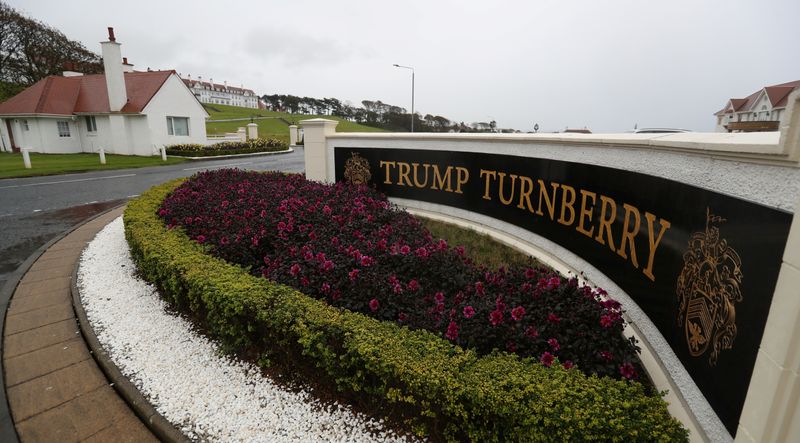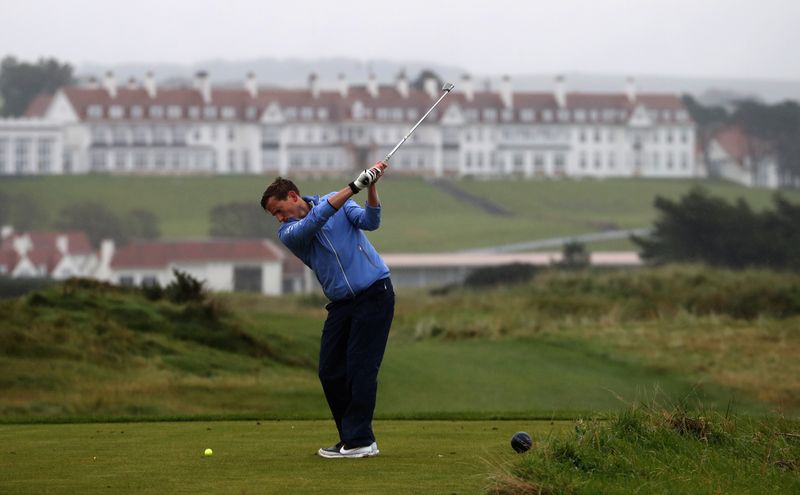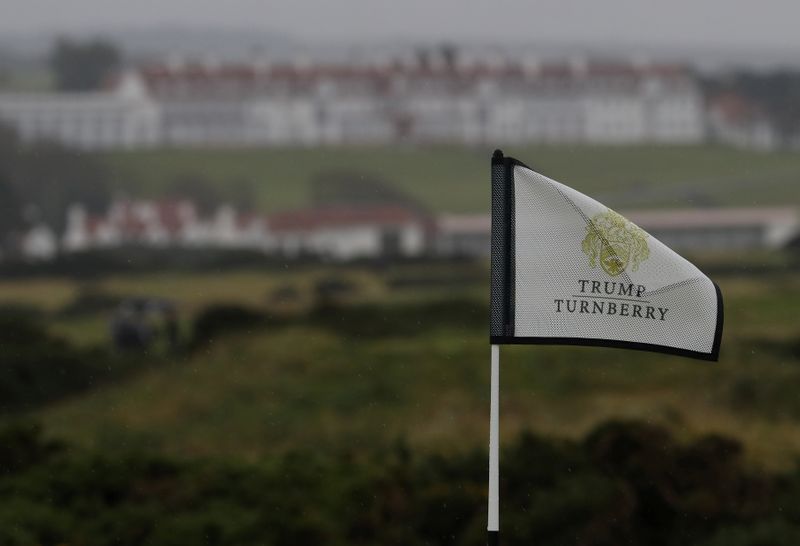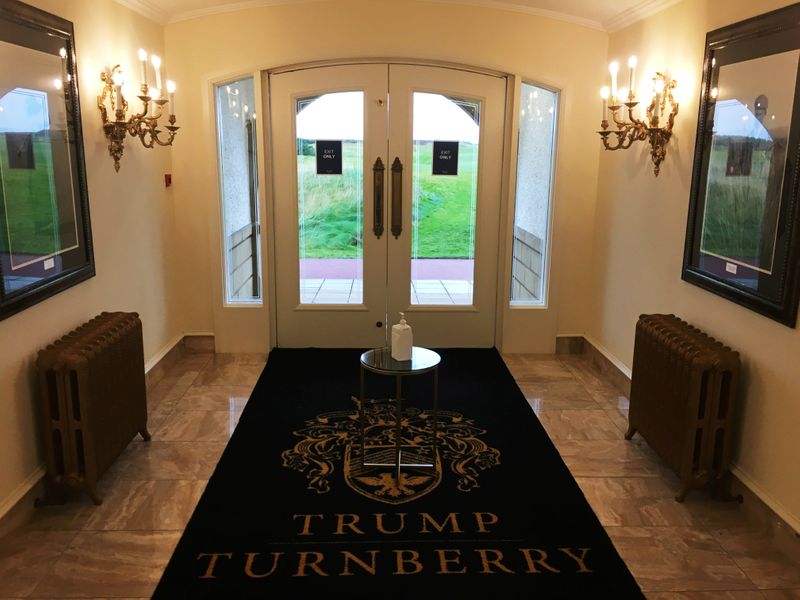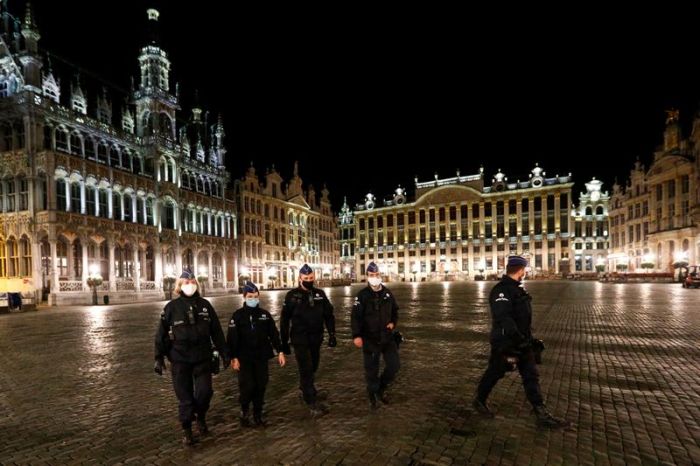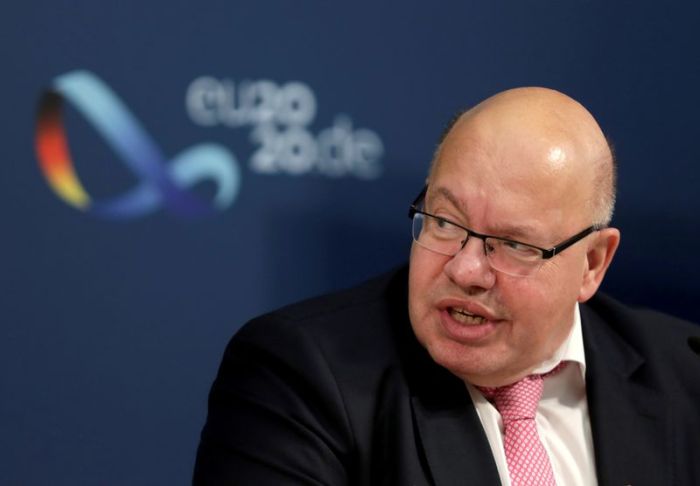TURNBERRY, Scotland (Reuters) – For Donald Trump, his golf courses are jewels in his self-branded business empire, from the swaying palm trees of Trump National Doral in south Florida to the panoramic sea views of Trump Turnberry on the windswept west coast of Scotland.
When running for U.S. president in 2016, Trump pointed not only to the prestige of his golf course portfolio, but also to the strategy the resorts represented. Facing skepticism at the time about his track record as a businessman, Trump told Reuters that those who focused on the operating losses at his courses were missing the point. The “big play” was developing real estate at the properties, he said.
“My golf holdings are really investments in thousands, many thousands of housing units and hotels,” Trump said in the 2016 interview, adding that the courses were in prime locations such as near Manhattan. The strategy, he said, involved building homes on and around fairways purchased at a relative bargain. The formula, he added, would make his portfolio of courses “worth many times what I invested.”
Today, as he campaigns for a second presidential term ahead of a Nov. 3 election, his business, the Trump Organization, appears to have made little progress in turning that vision into reality.
A Reuters review of satellite imagery and publicly available property filings in the United States and Europe shows that over the past decade, the Trump Organization hasn’t built a single residential or holiday home at any of the 11 golf properties that according to land records and the president’s financial disclosures are owned outright by the business. Nor has the Trump Organization secured rezoning rights to build additional homes at any of those properties over the period, according to spokespeople for planning authorities, databases of planning applications and minutes of planning board meetings.
Trump did in 2008 obtain rights to rezone farmland and a coastal reserve in Aberdeenshire, Scotland, to build hundreds of residences subject to building a golf course and a large hotel. While the Trump Organization has converted a manor house into a hotel and built other guest accommodation, neither he nor the Trump Organization have constructed any homes there.
The Trump Organization has invested more than $1 billion in the 11 wholly owned golf properties since his first purchase in the late 1990s, according to a Reuters calculation based on information provided by the company, its executives in media interviews and public records. That sum includes hundreds of millions of dollars spent on revamping his golf resorts, according to the group’s public statements.
“Whatever he thought would happen when he bought these courses, doesn’t seem to have panned out,” said Deepak Malhotra, a professor at Harvard Business School, whose work focuses on negotiation and deal making.
Eric Trump, one of the president’s sons who oversees the business, in a statement said: “We have the greatest golf properties anywhere in the world and just celebrated one of the best years in the history of Trump Golf,” and that “our business was up year-over-year.”
“We are incredibly proud of the portfolio we have built,” he added in the statement.
The White House declined to comment.
The Trump Organization, which is owned by Donald Trump, is the umbrella group for his numerous businesses. He placed the organization in a trust after being elected, and the business is now overseen by two of his sons. In addition to golf properties in the United States, Britain and Ireland that it owns outright, the Trump Organization leases three other courses. It has contracts to manage or license its name to several other existing or planned golf properties.
Trump, himself a keen golfer, has said in media interviews over the years that he purchased his courses cheaply – frequently buying them out of bankruptcy for less than the previous owner spent building them. “The golf courses are doing very well but they are development deals,” said Trump during the 2016 Reuters telephone interview. Trump said in the interview that he had spent “much less” than $1 billion on the golf portfolio.
The then-presumptive Republican presidential nominee didn’t specify a time frame for completing his vision. “At some point the company will do them. Hopefully, I won’t because I will be president, but we’re in no rush to do them.”
The Trump Organization has since 2004 sold some homes and housing lots around his golf properties in Westchester County, New York, and near Los Angeles. But these holdings were already zoned for such housing when Trump purchased them, according to planning documents and deeds lodged with the local counties.
PRESSURE ON THE BUSINESS
Meanwhile, revenues have stagnated in recent years. The combined revenues for the 11 golf clubs Trump’s group owns outright have increased less than inflation for the five-year period through 2019, the president’s financial disclosures show.
Overall, his golf resorts have racked up losses of $315.6 million since 2000, according to a New York Times report on Trump’s tax returns last month. Reuters was unable to confirm the contents of Trump’s tax returns.
The losses come as other revenue streams – such as making reality television shows and deals to license his name to apartment buildings – is drying up, according to the president’s financial disclosures.
The Trump Organization, which is privately owned, does not publicly disclose its earnings or the value of its assets.
When Reuters asked Trump about his wealth during the 2016 interview he cited an estimate of his net worth at the time by Forbes business magazine of between $4 billion and $5 billion, but said he believed the figure should be higher because it didn’t include a standalone valuation for his brand. In March this year, Forbes placed Trump’s wealth at $2.5 billion, including $416 million it estimated was the value of the 14 golf properties he owned or leased – less than half of what Reuters calculated his company invested in the 11 golf assets it owns outright.
Using golf courses as a springboard for development profits is a well-established strategy. Investors typically target properties with few legal or logistical restrictions to development, specialists say. Many of Trump’s properties, however, have restrictions such as legal controls on land use and environment protections or face local resistance to development, according to property records, planning officials and specialists.
Time frame is another distinction: Builders who specialize in redeveloping courses generally focus on sites where rezoning can be achieved within a few years, and rarely keep their courses open after acquisition, said Lisa Dilts, an Orlando-based consultant who advises developers seeking to buy courses for home construction.
“If you were following Trump as an investor you would have to scratch your head,” said Michael Kahn, a consultant and former developer based in St. Petersburg, Florida.
“A THOUSAND HOUSES”
At the seaside golf resort of Turnberry on Scotland’s west coast, the white lighthouse and views of a granite island in the distance have served as the backdrop to battles between the sport’s greats such as Jack Nicklaus and Tom Watson.
Trump, whose mother was Scottish, purchased the golf resort and more than 200 acres of surrounding agricultural land in 2014. He boasted in the 2016 Reuters interview that he “would have the right to build at least a thousand houses on Turnberry, if I wanted to.”
But he hasn’t received such rights, according to the local authority, South Ayrshire Council. His organization has lobbied the council to rezone his surrounding agricultural land and a disused World War One airstrip to allow for the construction of about 225 residential and holiday homes, said a council spokesman and two local councillors. However, the council last month didn’t include that revision in its most recent five-to-ten year development plan, council documents show.
Council spokesman Kenny Ross declined to say why council planners rejected the Trump group’s request. The council earlier this year rejected a separate zoning request from another party for a commercial and residential development on land near Turnberry, saying there was already sufficient zoned land in the area, according to council records.
One afternoon in early October, Turnberry club member Sean O’Sullivan walked past a lush golfing green surrounded by revetted bunkers, praising the grass as “like velvet.”
But he wouldn’t build a house there, said O’Sullivan, who owns a building company near Glasgow.
“I can’t see the demand,” he said, noting the modest surrounding South Ayrshire community, far from a city and with few transport links.
REZONING PROGRESS
On Scotland’s east coast, north of the city of Aberdeen, sits the only golf course where the Trump organization has obtained building rights on the surrounding land.
But on that land, he hasn’t built any homes.
In 2006, Trump bought more than 1,000 acres near the village of Balmedie. Two years later, he secured permission in principle from the Scottish government to build about 1,500 holiday apartments and residential homes on the farmland provided that he also built a large hotel and a championship-level golf course.
In the 2016 Reuters interview, Trump said that securing the approval was evidence of his rezoning abilities, especially because he succeeded in obtaining permission to build a golf course on a protected conservation area. “I bought the land for the right price because you weren’t even allowed practically to walk on the dunes, let alone build major golf courses there,” he said.
Scotland, hoping for a tourism boost, viewed the prospect of thousands of new jobs generated by the resort as a powerful argument to overrule environmental concerns, according to remarks by government ministers at the time.
In September last year, Trump scored a victory when Aberdeenshire Council agreed his Trump Organization could proceed with building 500 private homes without fulfilling the 2008 condition of building a large hotel, according to council records.
The council told Reuters talks are ongoing to finalize matters that would allow construction to begin, including how much the Trump Organization will contribute to help upgrade local infrastructure and meet affordable housing needs.
According to a website for the project, plans include townhouses and mansions at prices of up to £1.3 million ($1.69 million). Those prices equate to a premium on a per square foot basis of roughly 20% above other high end properties in the Aberdeen area when compared to prices advertised by real estate agents.
Estate agents said that the local market would take time to absorb so many high end homes, especially amid weakness in the North Sea oil industry.
“Will you get a dozen people who want to boast to their friends that they live on a Trump course? Probably,” said Eric Shearer, a partner with British real estate agency Knight Frank, who helped sell the land to the Trump Organization and who regularly enjoys playing Trump’s course. “Will you have 500 of them? Absolutely not.”
Trump, in the 2016 Reuters interview, expressed confidence that demand would recover.
DEVELOPMENT RESTRICTIONS
In some instances, Trump faces pre-existing restrictions to development.
Trump Organization properties in Jupiter, Florida, Colts Neck in New Jersey and near Charlotte, North Carolina, can only be operated as golf courses and cannot be repurposed for other uses, according to deed restrictions lodged with the local municipalities.
And in Los Angeles County, where his cliff-top Trump National Golf Club sits, the local municipality and other agencies require the site’s owner to maintain open space and to preserve local flora and fauna, according to planning documents. The previous owner had agreed to preserve open spaces and public access in order to secure zoning rights for the 75 homes that Trump in 2002 purchased the property with.
The course was among those Trump in the 2016 Reuters interview identified as having big potential for development. But the restrictions in place mean it will be challenging to secure rights to build additional housing, real estate lawyers said. For one thing, the local leadership and residents have strongly resisted attempts by builders to more intensely develop the area, said William Koehler, a Los Angeles-based lawyer who specializes in zoning matters.
Added Koehler: “Knowing the composition of the community out on the peninsula and historically, the way they have reacted (to development), I think it would be a real uphill battle.”
(Reporting by Tom Bergin; Additional reporting by Jeff Mason and Steve Holland; Editing by Tom Lasseter and Cassell Bryan-Low)

